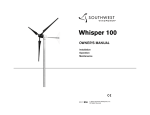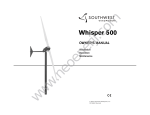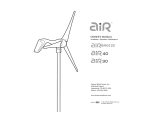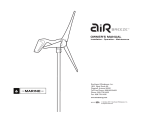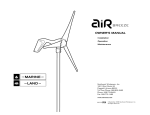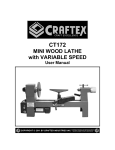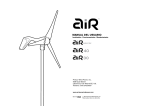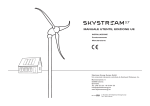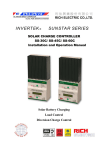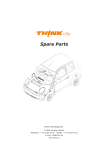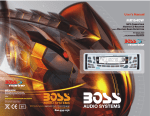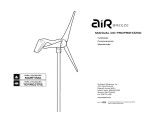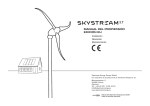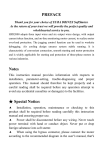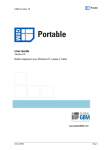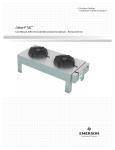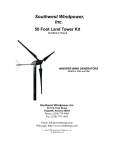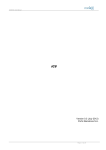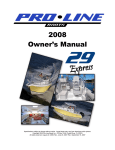Download Manual - Southwest Windpower
Transcript
Whisper 200 Owner’s Manual Installation Operation Maintenance © 2012 Southwest Windpower, Inc. All Rights Reserved TABLE OF CONTENTS SWWP Welcome Letter ............................................................................................................... 3 Safety & Tips.......................................................................................................................................... 4 Whisper 200 Technical Specifications.............................................................................. 5 Example of Off-Grid Installation............................................................................................ 6 PRIOR TO INSTALLATION Siting Tips................................................................................................................................................. 7 Tower Selection.................................................................................................................................... 8 Arrival Kit................................................................................................................................................... 9 System Wiring....................................................................................................................................... 10 Battery Sizing Tips............................................................................................................................ 11 Battery Configuration and Location ................................................................................. 12 Wind Turbine Electrical Tests....................................................................................................13 INSTALLATION *For field installation it may be useful to print this section..............14 Setting Wind Turbine Voltage...................................................................................................15-16 Mounting Wind Turbine On Tower.........................................................................................17-20 Tail Installation...................................................................................................................................... 21-22 Blade and Nose Cone Installation....................................................................................... 23-26 Whisper Controller – Mounting.............................................................................................. 27 Whisper Controller – Wiring...................................................................................................... 27-28 Whisper Controller - Circuit Board Switches and Reset Button................ 28-29 OPERATION AND ADJUSTMENTS Operation of the Whisper Controller.................................................................................... 30 1. Whisper Controller Overview......................................................................................... 30 2. Normal Operation – Whisper Controller.............................................................. 30 3. Diversion Switch...................................................................................................................... 30 4. LED Operation.......................................................................................................................... 30 5. Setting Regulation Voltage (without Display).................................................. 30 6. Whisper Controller Display.............................................................................................. 31 Display Menu Ring Structure.............................................................................................. 31 Display Menu Functions.......................................................................................................... 32 MAINTENANCE AND REPAIR Maintenance – Monthly.................................................................................................................. 33 Maintenance - Annual...................................................................................................................... 33 Maintenance Log................................................................................................................................. 34 Troubleshooting - Table: Symptoms of Mechanical Problems........................ 35 Troubleshooting - Electrical Diagnosis............................................................................... 36 Troubleshooting - Voltmeter Test............................................................................................37 Troubleshooting - Table: Symptoms of Controller Problems............................ 37 Troubleshooting - Table: Symptoms of Electrical Problems.............................. 38 Whisper 200 Exploded View...................................................................................................... 39 Whisper 200 Exploded View Parts List............................................................................. 40 Whisper Wind Turbine Warranty Agreement.......................................41 Whipser 200 Owners Manual 3-CMLT-1033-02 Revision E 2 Whisper 200 Owner’s Manual, Rev E Southwest Windpower Congratulations on your purchase and welcome to our family! Dear Whisper™ Owner, Thank you for your purchase of a Whisper wind turbine. We congratulate you on your choice and are confident you will experience years of dependable service. Before going any further, please complete and return the enclosed Warranty Registration Card. The conditions of your warranty are dependent upon the proper installation of Whisper. Furthermore, this will assure you of being kept up-to-date with the latest developments from Southwest Windpower. These include new options, performance tips, updated software to maximize output and user notices. It is important to know that we do not sell or distribute your information to any third party. We understand your privacy is important. Again, welcome to our family and thank you for investing in the future of wind energy with Whisper. Sincerely, Southwest Windpower CE Compliance: The CE marking is a mandatory compliance requirement in EMEA and the UK and although it is self-certification, testing and evidence support testing is preferred from an independent test house. All Southwest Windpower turbine are third party tested and fullfil all the relevant provisions of the following directives: Machinery Directive 2006/42/EC, Low Voltage Directive 2004/95/EC, Electromagnetic Compatibility Directive 2004/108/ EC. The report and declaration of conformity are available for inspection on request. The serial number refers to a specific Southwest Windpower product. This product is considered compliant to CE. Enter the serial and model number below Serial Number __________________________________ Model Number __________________________________ Southwest Windpower Inc. 1801 W. Route 66 Flagstaff, AZ 86001 USA [email protected] (928) 779-9463 Southwest Windpower GmbH Mannesmannstr. 6 50996 Cologne Germany Tel: +49 (0) 221 16 53 94 50 www.southwestwindpower.eu Designed in the USA by Southwest Windpower. Manufactured under license by Luminous Renewable Energy Solutions, India. Whisper 200 Owner’s Manual, Rev E 3 Important Safety Instructions Locate your tower well away from occupied buildings and power lines; a minimum of 76 m (250 ft) is recommended. Read these instructions in their entirety before installing or operating. SAVE THESE INSTRUCTIONS. Enclosed are important instructions that must be followed during installation and maintenance. Turn Whisper “OFF” and contact Southwest Windpower Technical Service if unusual noise or operation is observed. 76 m (250 ft) High voltage systems present a shock hazard and should be wired and maintained by a qualified and licensed electrician. Install Whisper on a calm day - no wind at ground level. NEVER place objects on top or near the Whisper Controller enclosure. In this manual IMPORTANT: Please take note TIP: Helpful information WARNING: Risk of injury or death - proceed with extreme caution MARINE: Information specific to corrosive environments 4 Whisper 200 Owner’s Manual, Rev E These devices must dissipate heat as part of normal operation. FAILURE AND FIRE may result if airflow is blocked. Recommended Tools, Equipment and Materials for Installation Rounded File Electrical Tape Ground Rod & Clamp Electrical Wire and Voltmeter Wrenches (2) 13mm and 17mm or Adjustable Wrenches Torque Wrench (20N-m or 15ft-lb) and 17mm Socket Electric Drill Motor & 10mm (3/8’’) Metal Cutting Drill Bit Sodering Iron and Solder or Split Bolt Connectors Leather or Strong Fabric Strap (secures casting while handling) Cable Grip/Strain Releif (support wires inside tower) Metric Hex Wrench Set Loctite 242 Center Punch Tool (marks for drilling) Sawhorses Pliers Small Flashlight Whisper 200 Technical Specifications WHISPER 200 Turbine casting pivots open to a 45 ° angle creating a potential pinch point. Pivot Point Rated Power 1000 watts at 11.6 m/s (26 mph) Monthly Energy 200 kWh/mo at 5.4 m/s (12 mph) Start-Up Wind Speed 3.1 m/s (7 mph) Rotor Diameter 2.7 m (9 ft) Voltage 12, 24, 48 VDC*; HV Available at 120v, 230v Overspeed Protection Patented side-furling Turbine Controller Whisper controller (Optional with all Units) Mount 6.35 cm pipe (2.5 in schedule 40) Body Cast aluminum with corrosion resistant finish Blades (3) Carbon reinforced fiberglass Survival Wind Speed 55 m/s (120 mph) Weight 30 kg (65 lb) box: 39.46 kg (87 lb) Shipping Dimensions 1295 x 508 x 330 mm (51 x 20 x 13 in) Warranty 5 year limited warranty *Power ratings are normalized for sea level. Potential Pinch Point Rotor Heaviest Part of Casting Southwest Windpower strongly recommends: Straping or securing the casting (as shown below) while handling so it cannot pivot open. * The Whisper Controller is factory set for 24-volt operation. If your system is other than 24 volts, the controller MUST be configured to your system voltage. Ensure turbine voltage is consistent with rest of your system voltage. Note the weight above. Use safe lifting techniques and protective footwear. Do not remove strap until casting is secure on tower. Whisper 200 Owner’s Manual, Rev E 5 EXAMPLE OF AN OFF-GRID HYBRID INSTALLATION Whisper wind generator PV array Batteries provide electricity to home via inverter Inverter PV Charge Controller PV panels provide electricity to batteries 6 Whisper 200 Owner’s Manual, Rev E Battery bank Whisper Charge Controller Whisper provides electricity to batteries 1 1 2 2 3 3 PRIOR TO INSTALLATION Siting Tips PROPER SITING = Better Performance & Increased Longevity Look at vegitation deformation to determine best area and prevailling wind direction. Prevailing wind ATYPICAL SITING CONSIDERATIONS Prevailing wind Prevailing wind Prevailing wind 1 2 1 Coastal or Lakeside 3 1 Trees and taller structures can be down-wind. 1 2 2 3 2 1 2 3 3 3 0 No Deformity I II 5-9 mph* 8-11 mph* wind Brush & Prevailing Slight Slight Flagging Flagging IV III V 12-16 mph* Complete Flagging 10-13 mph* Moderate Flagging 14-18 mph* Partial Throwing VI 15-21 mph* Complete Throwing VII 22-higher mph* Carpeting 1 Griggs-Putnam Index. *Probable mean annual windspeed. Data prepared by E.W. Prevailing wind Prevailingor wind Coastal Lakeside 1 Hewson, J.E. Wade, and R.W. Baker of Oregon State University 1 1 2 2 3 3 2 1 2 EXCESSIVE TURBULENCE = Fatigue Damage & Shorter 3 Turbine Life Prevailing wind Ridge Tops 2 3 2 1 3 Ridge Tops Wind compresses as it blows over the top of a hill, increasing the wind speed. Prevailing wind 1 1 Coastal Lakeside Prevailingor wind Prevailing wind 1 3 1 2 3 2 Excess Turbulence 3 3 2 1 Ridge Tops Prevailing wind 3 2 Plateau/Mesa2 1 2 3 Plateau/Mesa 3 Site the generator far enough from the cliff to avoid turbulent wind. 76 m (250 ft) Turbine should be a minimum of 76m (250 ft) away from and 6m (20 ft) above obtacles. Coastal or Lakeside Ridge Tops Prevailing wind Plateau/Mesa Prevailing wind 1 2 3 Whisper 200 Owner’s Manual, Rev E 7 Prevailing wind 3 3 2 1 Plateau/Mesa Tower Selection and Installation Lattice Towers Less-expensive More-expensive Larger Footprint (radius is 1/2 - 3/4 of tower height) Smaller Footprint Tower height Guyed Towers 150’ 46m 16 mph 7.3m/s 120’ 37m 15.5 mph 7 m/s 90’ 27m 14.7 mph 6.6 m/s 60’ 18m 13.5 mph 6 m/s 45‘ 14m 12.8 mph 5.7 m/s 33’ 10m 12 mph 5.4 m/s 0 0 20% 41% 75% 100% 124% Increase in wind power Calculations based on Power Law Exponenet 0.02 (In area of tall row crops, hedges, a few trees). Guyed tower Self-supporting lattice tower Soil and wind conditions vary; towers and tower foundations must be designed for your specific location. 8 Whisper 200 Owner’s Manual, Rev E Prevent tower climbing by unauthorized persons or children. Never climb without proper safety equipment. Always stop the blades before climbing the tower. Both falling from the tower and contact with the spinning blades can be lethal. Wind Speed Wind speed increases with height. Higher towers also raise generators above the air turbulence that can exist close to the ground. Tower Selection Arrival Kit Generator Tail Boom Optional Controller Blade Extensions Nosecone & Hardware Kit User’s Packet Tail Fin User’s Packet Blades User’s Manual 5-Year Warranty & Other Docs Tail Fin Stickers IMPORTANT: Properly complete the warranty registration card; failure to complete and return the card may affect your warranty. Whisper 200 Owner’s Manual, Rev E 9 System Wiring TIP: See the Whisper Controller installation section for complete wiring details. Batteries may emit explosive and irritating gas while charging. Use protective gloves and safety glasses. Distance = A + B Never make any electrical connection, light a match or make a spark near a recently-charged battery. Controller B Turn off all loads, and look away when making a final battery connection. A Wire size from wind generator to controller based on voltage configuration and distance (Distance = A + B) Size 12 V 24 V 48 V Distance* Distance* Distance* 4 mm2 (12 AWG) — — 66 m (216 ft) 6 mm2 (10 AWG) — — 106 m (346 ft) 10 mm (8 AWG) — 42 m (138 ft) 168 m (552 ft) 16 mm2 (6 AWG) — 66 m (218 ft) 266 m (872 ft) 25 mm (4 AWG) 26 m (84 ft) 103 m (339 ft) 414 m (1356 ft) mm 2 2 2 27 mm (3 AWG) 42 m (136 ft) 165 m (542 ft) 660 m (2168 ft) 34 mm2 (2 AWG) 52 m (170 ft) 208 m (682 ft) 832 m (2728 ft) 42 mm2 (1 AWG) 66 m (216 ft) 262 m (860 ft) 1048 m (3440 ft) 54 mm (0 AWG) 82 m (274 ft) 335 m (1098 ft) 1338 m (4390 ft) 67 mm2 (2/0 AWG) 104 m (342 ft) 416 m (1364 ft) 1662 m (5454 ft) 85 mm (3/0 AWG) 132 m (434 ft) 528 m (1730 ft) 2110 m (6924 ft) 107 mm (4/0 AWG) 166 m (546 ft) 664 m (2177 ft) 2654 m (8710 ft) 2 2 2 2 *If using aluminum wire, multiply the distances in the table by 0.65. Distances are one way from the turbine connection to Whisper Controller terminals. 10 Whisper 200 Owner’s Manual, Rev E Simple Tips for Deep Cycle Battery Bank Sizing In preparation for battery sizing, know: ELECTRICAL USAGE - the amount of energy consumed 1 day in Watt-hours (Wh) DAYS OF AUTONOMY - days of battery back-up required if unable to charge the batteries by any means. DEPTH OF DISCHARGE - limit of energy withdrawal to which you will subject the deep cycle battery bank. *Deeper discharge = Shortened battery life. • Recommeded: never discharge a deep cycle battery below 50% of its capacity. • Off-grid applications, a 25% DoD will extend battery life significantly. TEMPERATURE - Standard for most battery rating is 25 ° C (77 ° F). Cold temperatures = reduced battery capacity High temperatures = shortened battery life RECOMMENDATION - Keep the number of parallel strings of batteries to three or fewer. More than three strings of batteries, risks shortening battery life due to uneven charging. • • Batteries in Series = Voltage is Additive Batteries in Parallel = Ah is Additive *Example: 2 12V 100Ah Battery Bank Series 24V 100 Ah Parallel 12V 200 Ah CALCULATIONS - calculate battery bank size, use example below: • • • A system load of 6,000 Watt-hours per day 3 Days of Autonomy (back-up) needed Planned Depth of Discharge (DoD): 40% • Battery bank ambient average low 15.6 °C (60 ° F) • A 48V system STEPS: EXAMPLE: 6,000 Wh/day 1.) Identify total daily use in Watt-hours (Wh) 2.) Identify Days of Autonomy (back-up days); multiply Wh/day by this factor. 3.) Identify Depth of Discharge (DoD) and convert to a decimal value. Divide result of step 2 by this value. 4.) Select the multiplier corresponding to the lowest average temperature your batteries will be exposed to. Multiply result from Step 3 by this factor. *Result is minimum Wh capacity of battery bank: Temp in degrees °C ° F Factor 26.7 80 + 1.00 21.2 70 1.04 15.6 60 1.11 10 50 1.19 4.4 40 1.30 1.1 30 1.40 -6.7 20 1.59 5.) Divide result from Step 4 by system voltage. Result is the minimum Amp-hour (Ah) capacity of your battery bank. 3 days of Autonomy: 6,000 x 3 = 18,000 Wh 40% DoD: 18,000 / 0.4 = 45,000 Wh 15.6 ° C (60 ° F) = 1.11 45,000 x 1.11 = 49,950 Wh 49,950 / 48 = 1,040 Ah Whisper 200 Owner’s Manual, Rev E 11 Battery Configuration and Location Use the diagrams below to determine the series/parallel arrangement for your system voltage. Please note: based on 6V batteries. RECOMMENDED: • Locate battery in moderately stable room temperature, dry unoccupied building. • If battery is in an occupied building, an enclosure with vent to outside is required. Follow code. • Batter enclosure: - Allow 5 cm (2 in) on all sides for ventilation. - Allow 60 cm (2 ft) vertical clearance for maintenace access. • To minimize the possibility of EMI (electromagnetic interference), the line from the battery to the Whisper Controller should be less than 10 feet (3 m). Battery Fuse Installation (Consult local electrical codes) Battery positive 12 Volt Configuration To controller To inverter To controller To inverter 48 Volt Configuration To controller To inverter To controller To inverter 24 Volt Configuration To controller To inverter To controller To inverter Nut and bolt Fuse included (SWWP recommends using a fuse holder to support wire weight) 12 Whisper 200 Owner’s Manual, Rev E Wind Turbine Electrical Tests Complete these tests before mounting blades to rotor. These tests confirm the wind generator is ready to install on the tower. Ground Test Open Circuit Test Check resistance to ground on any wire. Resistance must exceed 10,000 ohms; on many digital meters this will show a reading of “OL”. When the wires are unconnected the wind generator rotor should spin freely. Short Circuit Test When all the wires are shorted together the alternator should turn hard. Phase to Phase Test When any two wires are shorted together the alternator should turn lumpy as though there are smooth and bumpy portions of the rotor. Whisper 200 Owner’s Manual, Rev E 13 INSTALLATION SECTION This section of the manual includes pages 15-29. The pages cover: Setting Wind Turbine Voltage...................................................................................................15-16 Mounting Wind Turbine On Tower.........................................................................................17-20 Tail Installation...................................................................................................................................... 21-22 Blade and Nose Cone Installation....................................................................................... 23-26 Whisper Controller – Mounting.............................................................................................. 27 Whisper Controller – Wiring...................................................................................................... 27-28 Whisper Controller - Circuit Board Switches and Reset Button................. 28-29 If it is necessary to print installation instructions, these are the primary pages you will need. 14 Whisper 200 Owner’s Manual, Rev E INSTALLATION Set Wind Turbine Voltage IMPORTANT: The stator wires are coated with varnish that MUST The Whisper 200 wind turbine and controller must be configured for the correct system voltage - 12, 24, or 48 volts. • Whisper controllers are shipped from the factory configured for 24 volt operation. • The correct turbine voltage is set by altering the 12 stator wire and 3 brush wire connections. be removed to make a good connection. Remove varnish by scraping with sharp edge or lightly sandpapering the wire. • Access wires by removing the “Multi Voltage” cover on the turbine housing. • The brush wires are interchangeable and not labeled. The brush wires are the larger multistrand wires; 10AWG. • The stator wires are numbered and color coded with a wire sleeve. For example stator wire “Red 3” has a red sleeve with the number “3” printed on it. Wire “Red - “ has a red sleeve with no number. The “-” indicates there is no number. *Refer to table on next page for specific stator and brush wire connections. • Cut off the twisted ends of the stator wires and strip off approximately 25 mm (1 inch) of insulation. • Hold stripped ends of the wires parallel to each other and twist together clockwise direction before installing the wire nut. • Trim wires and twist on the appropriate color wire nut (indicated in the table). Push hard on the wire nut while twisting clockwise. • Coat wire nuts and terminal strip connections with dielectric grease to protect wires against corrosion. *36V configuration has been removed from this manual. Contact Southwest Windpower technical support for 36V configuration. Whisper 200 Owner’s Manual, Rev E 15 Voltage Configuration Wiring Table Reference the following table to determine the correct brush and stator wire connections for your voltage configuration. Red Wire Nuts 12 V Brush Wire Brush Wire Brush Wire White 1 White — Red 1 White 3 White 2 Red 3 Black 2 Red 2 Black 1 Black — Red — Black 3 Red Wire Nuts Brush Wire 24* White 1 V White 3 Yellow Wire Nuts Brush Wire Brush Wire White — White 2 Red 2 Black 1 Red 3 Red 1 Red — Black 3 Black — Black 2 Red Wire Nuts Yellow Wire Nuts 48* Brush Wire Brush Wire Brush Wire White — White 2 Red 2 V White 1 Red — Black 1 Red 1 Black — White 3 Red 3 Black 2 Black 3 *For high voltage Whisper, use the 24V configuration for a 120V HV Stator, and the 48V configuration for the 240V HV Stator. 16 Whisper 200 Owner’s Manual, Rev E Mount Turbine On Tower TIP: Use medium-strength thread locking compound on all fasteners. Tower Insert Tower Insert Kit For 64 mm insert (2.5 inch Schedule 40 Pipe –2.875 O.D. x .20in Wall) Check Fit Engagement hole 64 mm (2.5 inch) insert 2 Item Description Qty: 1 Set Screw (M6 X 20) 2 2 Set Screw M8 X 35 4 3 M8 SS Nylock Nut 4 Tower 1 3 MARINE: If you are installing your Whisper in a corrosive environment, use a marinized Whisper and apply Tef-Gel to all threaded holes to prevent screws from becoming permanently seized into place. Whisper 200 Owner’s Manual, Rev E 17 Tower Preparation 3) CUT 3. DASHED LINE 4. .375 9.53 5. .375 9.53 4.524 114.91 TAB PLACE TAB ALIGN WITH TOP OF TOWER 2.5" SCHED 40 PIPE 9.048 229.81 2.500 63.500 Center punch and mark tower for drilling. MARKS SHALL BE ALIGNED WHEN TEMPLATE IS WRAPPED AROUND TOWER 2.50" SCHED 40 PIPE 1) 2) 8.00 203.20 DRILL TEMPLATE INSTRUCTIONS: 1. 2. • Align with top of tower DIMENSIONS ARE IN MILLIMETERS, DIMENSIONS IN BRACKETS 3. CUT OUT TEMPLATE USING DASHED LINE AS SHOWN. 4. ALIGN TEMPLATE TO TOP OF TOWER AND SECURE IN PLACE. 5. WITH CENTER PUNCH, MARK 4X HOLE CENTERS ON TOWER. 1. 6. THIS SHEET SHALL BE PRINTED FULL SCALE, AFTER PRINTING VERIFY DIMENSION NOTED. ARE IN INCHES. TEMPLATE - DRILL TOWER - WHISPER 100/200 • Wrap template around tower P/N: 3-CMLT-1051-01 REV C until tab arrows REMOVE TEMPLATE, CHECK DIMENSIONS AND DRILL 4X HOLES. line up. • Secure template with tape Pipe dimensions Recommended: Begin drilling with small bit & work up to 10MM (3/8”) metal cutting drill bit. 18 Whisper 200 Owner’s Manual, Rev E 4) Drill center punch marks Install Tower Insert 1) 2) 3) Feed tower insert onto yaw shaft Tower Insert Tower Insert Yaw Shaft Alignment Holes for M8 x 35 Set Screw 5) 4) M6 x 20 Set Screw Align hole of tower insert and yaw shaft Slot for Cable Strain Relief M6 x 20 Set Screw Secures Tower Insert to Yaw Shaft Whisper 200 Owner’s Manual, Rev E 19 Mount Turbine to Tower Tower insert Wires “from” Support wires by attaching to the tower insert Align holes on tower insert and tower Solder or split bolt connector Tower Wires to Whisper Controller Strain relief cable grip 1) Solder or use split bolts to make electrical connections. 2) Wrap connections thoroughly with electrical tape to prevent shorts to tower. 3) Support wires to avoid weight on slip ring wires and wire connections. 20 Whisper 200 Owner’s Manual, Rev E M8 x 35 Set Screw (4 Total) Tower Insert Flange Resting on Tower Tail Installation Item Description Quantity 1 Assembled Generator 1 2 Tail Boom 1 3 Tail Fin 1 4 Hex Bolts, M8 x 55 2 5 Nylon Washer, M8 x 31 2 6 SSTL Washer, M8 x 24 2 7 Nylock Nut, M8 4 8 Hex Bolt, M8 x 25 1 9 Hex Bolt, M8 x 70 1 3 7 2 7 1 5 4 6 9 8 Tail Installation Kit 3.) Tail Fin 2.) Tail Boom Torque Wrench 13mm Wrench 13mm Socket 7.) M8 Nylock Nut 6.) M8x31 Stainless steel Washer 9.) M8x70 Hex Bolt 8.) M8x25 Hex Bolt 4.) M8x55 Hex Bolts 5.) M8x31 Nylon Washer Whisper 200 Owner’s Manual, Rev E 21 Assemble Whisper Tail Fin Mounting Tail Boom Tail Boom M8x24 SS Washer M8x31 Nylon Washer M8x55 Hex Bolt 1) Attach tail fin. Not shown: M8 Nylock Nut M8x70 Hex Bolt 4) Align holes when pushing tailboom into casting. 5) Secure tail boom anchor. 6) Tighten casting to secure tail boom. M8x25 Hex Bolt 2) Apply Whisper sticker to top and bottom of fin. 3) Complete tailfin assembly. 7) Secure M8 nylock nuts Use 13mm or adjustable wrench 22 Whisper 200 Owner’s Manual, Rev E Whisper 200 Blade Installation Leading edge (rounded) Make sure diversion switch is in the “stop” position. 10 Flat (non-ground) end of blade extension attaches to rotor. Trailing edge (sharp) 11 7 Ground edge of blade extension face toward blade. Ground edge 6 Use thread locking compound (Loctite 242 or equivalent) on all bolts. 9 Torque all bolts to 24 N·m (18 lb-ft). Do not overtighten. 5 1 Paint dot. See note below. 2 3 IMPORTANT for MARINE units: The enclosed packet of TefGel should be used in threaded holes to prevent corrosion and screws becoming permanently seized into place. 2 4 3 IMPORTANT: Each turbine blade has a paint dot on the “front “ of the blade between the blade mounting holes. The blades should be bolted to the ground end of the blade extensions so that the paint dot is VISIBLE after the blades are mounted. Item Description Quantity Item Description Quantity 1 SS Blade Extension 3 6 Blade 3 2 SS Lock Washer, M10 6 7 SS Nylock Nut M10 6 3 SS Hex Bolt M10 x 40 6 9 SS Flat Washer M10 x 30 (Thick) 3 4 Nose Cone 1 10 SS Shaved Washer M19 x 30 3 5 SS Flat Washer M10 x 20 (Thin) 3 11 SS Hex Bolt M10 x 50 Whisper 200 Owner’s Manual, Rev E 23 BLADE INSTALLATION 6) Whisper 200 Blades 1) Blade Extensions 11) Hex Bolt M10 x50 3) Hex Bolt M10 x 40 7) M10 Nylock Nut 10) M10 x 30 Flat Washer - Shaved 9) M10 x 30 Flat Washer 5) M10 x 20 Flat Washer Loctite 242 Torque Wrench Blade Extension M10 x 20 Flat Washer M10 x 40 Bolt 24 Whisper 200 Owner’s Manual, Rev E Adjustable Wrench 17mm Socket Rotor Nose Cone Attachment Point Blade Extension to Rotor Attachment Point Attach blade extension to rotor. Attach nosecone to rotor. Rotor Plate M10 x 40 Hex Bolt M10 x 20 Flat Washer Rotor Blade to Rotor Plate Attachment Point Blade Extension Torque to 24 N-m (18ft-lb) Nosecone Ground edge of blade extension should face toward blade Ensure nose cone to rotor attachment hole lines up before tightening blade extensions. M10 x 40 Hex Bolt M10 x 20 Flat Washer Torque to 24 N-m (18ft-lb) Any two tip distances should be equal distances apart to reduce vibration. Whisper 200 Owner’s Manual, Rev E 25 Attach blades to blade extensions. M10 x 50 Hex Bolt M10 x 30 Flat Washer - Shaved M10 x 50 Hex Bolt M10 x 30 Flat Washer Not Shaved Ensure Paint Dot Faces Out Paint Dot Torque to 24 N-m (18ft-lb) Final Assembly 26 Whisper 200 Owner’s Manual, Rev E Whisper Controller – Mounting • When performing preliminary turbine to controller tests, temporarily mounting the controller close to wind turbine allows easy access while testing the turbine and controller functionality. • Perform turbine to controller tests prior to mounting blades. • Allow effective heat convection by mounting controller vertically against a wall. • The dump load side of the controller gets very hot, DO NOT mount near flammable or heat sensitive materials. • Controller is NOT rated for outside use and must be protected from the elements. Mount inside a protected building. *Controller can be mounted as shown below, or rotated 90 degrees with dump load on top. Turbine Inputs 12” wire 8” wire LEDs and diversion switch Anemometer Connection (optional) • Setting dip switch voltages before connecting to battery. See “Printed Circuit Board Switch Settings” section. • Avoid shorting battery leads together when connecting the battery. • Connect the battery to the controller. Confirm the microprocessor is energized by moving the diversion switch to the “stop” position; red LED should illuminate. • If not, momentarily depress the “reset” switch on the controller PCB. • Return the diversion switch to the battery position and observe the red LED to turn off. • When connecting the battery do not allow the connection to power the microprocessor on and off quickly. This could cause the microprocessor to lock up. • If the microprocessor locks up and reseting does not correct the problem, contact Southwest Windpower for instructions. • After successful startup, cycle red LED by toggling the diversion switch then switch to “Stop” • Connect turbine wires to controller (order is not important) *When the red LED is on, the turbine will not spin as long as at least two of its wires are connected, except in strong winds. Battery Outputs Earth Ground located inside controller between turbine & battery mounting blocks Dump Load Side/Hot Side Whisper Controller Optional Anemometer NRG #40 Ground Lug Conduit Knockouts (on bottom of controller) accommodates .75”, 1.25” & 1.5 Whisper Controller – Wiring Fuse Connecting Remove the Controller electronic cover and connect the battery, turbine and ground wires as shown in the accompanying schematic. Controller MUST be connected to the batteries BEFORE making the wind turbine connections. Correct polarity MUST be observed when connecting battery cables. Included Wire size for wiring to the battery (3 meters each way): 12V system: 1/0 gauge or larger 24V system: 2 gauge or larger 48V system: 6 gauge or larger Battery Bank Whisper 200 Owner’s Manual, Rev E 27 Dump Load Wiring • Wire the resistive “dump” load for the correct system voltage • Sufficient jumper wires are provided to achieve any system voltage configuration 8” wire Whisper Controller - Printed Circuit Board Switches and Reset Button Switches for setting system voltage Potentiometer 24 Volt Systems 12 Volt Systems 12” wire 48 Volt Systems 12” wire 12” wire Optional Anemometer Connection • Whisper Controller is designed to accomodate a model #40 NRG anemometer (www.nrgsystems.com; Item Number 1900). • Connect anemometer wires to labeled PCB terminal block. • Anemometers require specific polarity; observe the labeling on the terminal block connections. • If applicable, connect a grounding shield to the controller’s grounding terminal. • Mount anemometer close to turbine without entering the turbine’s swept area (see manufacturer’s installation instructions). Understanding Voltage Regulation: “Regulation-On” • Controller is regulating battery voltage and diverting power to the dump load • If the controller measures battery voltage above “regulation-on voltage” for more than 30-40 seconds, it begins diverting power “Regulation-Off” • Controller resumes battery charging • If the controller measures battery voltage below “regulation-on voltage” for more than 30-40 seconds, it stops diverting power and begins battery charging 28 Whisper 200 Owner’s Manual, Rev E Reset switch • Six switches on the PCB are used to set operating system parameters. • The default settings are suitable for most systems installations and should only be changed to alter system voltage. Reset Switch: • Whisper Controller operation is controlled by a microprocessor. • The PCB reset switch resets the microprocessor. Depressing the reset switch has the same effect as disconnecting a battery cable. • To reset momentarily press the reset button. If it is necessary to depress a second time, wait approximately 15 seconds. • Voltage regulation points set using the optional display setting will be lost if reset switch is depressed or a battery cable is disconnected; controller will revert to potentiometer set points. Printed Circuit Board Switch Settings Switches 1 and 2, System Voltage Select the correct system voltage by setting the position of switches 1 and 2 according to the following table. System Voltage Switch 1 Switch 2 12 Volt ON ON 24 Volt OFF ON 48 Volt OFF OFF Switch 4, Voltage Hysteresis, Default Setting “OFF” OFF Controller starts or stops charging at the voltage regulation points set through optional display or by the PCB potentiometer ON Voltage regulation-on point (battery stops charging) set using potentiometer increases by: - 1.0 volts for 12V systems - 2.0 volts for 24V systems - 4.0 volts for 48V systems Votage regulation-off point (battery charging resumes) is not affected Voltage hysteresis switch does not increase the regulation on and off set points using the optional display After changing the system voltage depress the reset switch to “read and save” the new voltage setting. Switch 5, Potentiometer Enable, Default Setting “OFF” Switch 3 , Time Hysteresis, Default Setting “ON” ON 30-40 second delay for controller to start or stop charging when regulation set point is reached OFF No-delay – charging will stop or start immediately when regulation set point is reached It is not necessary to depress the Reset Switch after changing the switch setting. *Southwest Windpower STRONGLY recommends Switch 3 remain in ON position ON Enables reading potentiometer voltage in real time. Resolution limits are: - 0.2 volts for 12V systems - 0.4 volts for 24V systems - 0.8 volts for 48V systems Voltage regulation points must be set using potentiometer not optional display OFF Prevents changing the voltage regulation point using the potentiometer It is not necessary to Reset after changing the switch 4 & 5 settings. Before adjusting the Voltage Regulation-On set-point understand that increasing the voltage will not increase the turbine’s output voltage or current. This set-point only adjusts the “shut-down” voltage for battery charging. Overcharging will significantly reduce a battery’s life expectancy. Switch 6, Default Setting “OFF” There is no function presently associated with this switch. SWWP recommends leaving the switch in the OFF position. Whisper 200 Owner’s Manual, Rev E 29 OPERATION AND ADJUSTMENTS Operation of the Whisper Controller Turbine Battery Remote Dispaly 2) Normal Operation – Interface mechanisms: LED, diversion switch, voltage regulation adjustment, PCB configuration switches and LCD display (if equipped) – Interface allows setting regulation voltage, monitoring system Whisper Contoller with display Whisper Controller Components Whisper Controller Display Whisper Controller Resistive Load bank (Dumpload) Whisper Controller Electronic Cover Diversion Switch and LED’s (Far Side) Whisper Controller Electronics Whisper Controller Regulation Potentiometer 30 Whisper 200 Owner’s Manual, Rev E 1) Overview — Controls and converts turbine power. Functions: - Rectifies power from wild AC to DC voltage - Contains diversion load & controls voltage regulation - Monitors voltage, current, energy production and wind speed (if equipped) – Optional LCD Display: - Offers instant access to operational parameters and performance measurements; voltage, current, power, energy, charge, peak power and wind speed (if equipped) - Display LEDs function same as controller LED 3) Diversion Switch – Diverts power from batteries to dump load to avoid battery overcharging – Considerations if activated: - Will not stop a spinning turbine but will not allow a stopped turbine to start spinning - If turbine blades are spinning, it is normal and safe 4) LED Operation Red LED = Power diverted to dump load; Green LED = Turbine is charging battery LED INDICATORS RED GREEN OFF ON Battery charging INTERPRETATION BLINKING OFF Power to diversion load to regulate battery voltage ON OFF Power to diversion load by operator request (via Diversion Switch or remote Display). 5) Setting Regulation Voltage (without Display) *See page 22 - Switch 5 • Turning the potentiometer clockwise (CW) increases the voltage set points. Use following chart for approximate potentiometer set points. Note: Determine the initial potentiometer position by turning fully counter clockwise (CCW). Count and record the number of turns. Pot Position Regulation Off Voltage Regulation On Voltage Fully CCW 12.0V 24.0v 36.0v 48.0v 13.0V 26.0v 39.0v 52.0v 1/4 Turns CCW 13.0V 26.0v 39.0v 52.0v 14.0V 28.0v 42.0v 56.0v Factory Preset 13.4V 26.8v 40.2v 53.6v 14.4V 28.8v 43.2v 57.6v 1/2 Turns CW 14.0V 28.0v 42.0v 56.0v 15.0V 30.0v 45.0v 60.0v 3/4 Turns CW 14.0V 28.0v 42.0v 56.0v 16.0V 32.0v 48.0v 64.0v Fully CW (18 turns) 14.0V 28.0v 42.0v 56.0v 17.0V 34.0v 51.0v 68.0v • Verify display function: text should appear on LCD display after display and batteries are connected to controller. • It may be necessary to adjust LCD contrast: - Locate small hole between buttons and LEDs - Insert small screwdriver through display cover - Turn clockwise to lighten - Turn counter-clockwise to darken • If text is still not visible, disconnect & reconnect cable to display to reset. Display Menu Ring Structure 6.) Whisper Controller Display (Optional) “B” Menu Function Button LCD Display Screen “A” Menu Function Button Green LED LCD Contrast Adjustment Red LED • Designed to mount on: – Whisper controller base unit (a short CAT5 Ethernet cable is provided) or 4” wall type switch receptacle • If mounted on controller, connect CAT5 to jack closest to diversion switch to disable controller LED • Mounting on Whisper Controller – Remove electronics cover – Remove sheet metal insert where display will mount – Use hardware provided to mount display to electronics cover – Hardware: 8-32 x 3/8” black oxide SS screws and 8-32 nuts with captive star washers • If mounted remotely, the display can be mounted up to 300 m (1,000 ft) from controller; longer CAT5 cable must be purchased by user. Whisper 200 Owner’s Manual, Rev E 31 Display Menu Functions 4) Mode Page • Displays current charge mode – If “ON” is displayed the battery can be charged; turbine will spin in adequate wind – If “OFF” is displayed turbine power produced is diverted to dump load; turbine will not spin in light winds – “A” menu button toggles the mode – “B” menu button returns to Regulation Set page • Controller can switch to “OFF” mode in the following conditions” – “OFF_REM” - turbine power is diverted to dump load via request from remote display – “OFF_MAN” - turbine power is diverted to dump load when diversion switch is moved to “Stop” position – “OFF_REG” - turbine power is diverted to dump load via automatc regulation at present voltage *Diversion switch set to “OFF” overrides Remote Display “ON” function 1) Main Page • Displays controller’s measurements: battery charging status, voltage, and current and turbine power and windspeed (if equipped) • Main display leads to four sub-pages by selecting “A” or “B” functions – “A” – Energy and History menu pages – “B” – Mode and Regulation menu pages 2) • • • Energy Page Displays accumulated kWh and kAh since last reset Accumulated data can be reset by selecting menu option “B” Menu option “A” goes to the History page 3) • • • History Page Displays average and peak windspeed and turbine power since reset Note: windspeed is only available if anemometer is installed Reset accumulation data by selecting menu option “B” Menu option “A” goes to the Main Display page 32 Whisper 200 Owner’s Manual, Rev E 5) Regulation Page Digitally set “regulation on” and “regulation off” voltages using the Regulation Setpage Menu • Select “A: CHANGE” for “Regulation ON” subpage for voltage changes – “B” menu button increases voltage to 17V maximum. At 17V, if pressed again, the voltage rolls back to 13V – “A” menu button brings up “Regulation OFF” subpage - “B” menu button increases voltage to a maximum of one volt lower than “Regulation ON” voltage. At maximum, if pressed again, the voltage rolls back to 12V - “A” menu button returns to Regulation Set page • Select “B:SKIP” to return to Main Display Page *Regulation Off voltage cannot be specified above Regulation On voltage MAINTENANCE AND REPAIR Maintenance – Monthly Maintenance - Annual 1) Test Diversion Control (check electrical wiring) • Divert the load by setting the diversion switch to “stop” in a moderate wind (charging but not furling) • No unusual difficulty or noise should be experienced in stopping the blade rotor • A noise during diversion can indicate a disconnected wire Lower the tower and give wind generator a complete inspection. Fix or replace any warn or loose parts. 2) Check Mechanical Condition • Watch and listen from the tower base. There should be no mechanical noise, rattle or vibration and the blades and tail must not wobble • If you hear mechanical noise, rattle or vibration, or see blade or tail wobble, lower the tower for inspection • If you experience any of these conditions, refer to Troubleshooting and Repair 3) Inspect the Tower • Follow all inspection and maintenance requirements of the tower manufacturer • Tighten all nuts and bolts, especially wire clips • Check for cracks and bent/broken parts at the anchors and base • Check for broken strands and tighten wires 4) Check the Battery • Consult your battery manufacturer maintenance guide • Tighten battery connections • Remove corrosion and protect terminals a) Check tightness of all tower and blade nuts and bolts b) Check all bearings c) Clean the blades with a mild detergent to remove all dirt and debris. Replace blades if they are cracked or damaged d) Check the pivot bushing and bore. Lay the turbine down while it is completely unfurled (the normal operating position), and see if you can wobble the lower half. If it wobbles significantly (noticeable play), then the bushing and/or bore is ovalized. Replace the bushing first and retest it. If it still wobbles then the castings need to be replaced. Do not tighten pivot pin nut. Tighten tower and blade mounting bolts. Whisper 200 Owner’s Manual, Rev E 33 Maintenance Log Observe monthly and annual inspection requirements. Record all maintenance and repair work. Date Problem/Observation 34 Whisper 200 Owner’s Manual, Rev E Action Taken Troubleshooting and Repair Table: Symptoms of Mechanical Problems Symptom Blade rotor is stationary, even in high winds Probable Cause Correction a) Ice in generator, or on blades a) Wait for warm weather. Leave running unless vibration is substantial b) Turn blades gently by hand and use thin material to dislodge debris c) Remove rotor and re-glue magnets – contact factory/ dealer/ distributor d) Contact factory or distributor b) Debris between rotor and stator c) Loose, broken or rubbing magnet d) Bad or worn bearing Blade rotor will not turn at all except in high wind, scraping or rubbing sound at low rpm, always stops at same blade position a) Same as above, except more likely to be high magnet or bad bearing. a) Same as above Blade rotor is hard to start, output is lower & there is more blade noise than usual; appears out of balance. a) Ice on blades d) Blade(s) on backwards a) Wait for warm weather. Leave running unless vibration is substantial b) Clean with mild detergent c) Replace damaged blade – contact factory/ dealer/ distributor d) See blade installation Blade rotor turns slowly, never spins rapidly a) Blades on backwards. a) See blade installation Tail, generator and tower vibrate or shake excessively at all or some wind speeds a) Blade out of balance a) Replace blade – contact factory/ dealer/ distributor b) Contact factory/ dealer/ distributor c) Contact factory/ dealer/ distributor d) Perform phase-to-phase testing SAFETY FIRST - shut down turbine until a physical inspection can be performed. Rattle or clunking from generator SAFETY FIRST - shut down turbine until a physical inspection can be performed. b) Dirty blades c) Damaged blade(s) b) Blade not tracking c) Rotor out of balance d) Shorted alternator or wiring a) Generator loose in tower. Rotor loose on shaft, loose tail, missing rubber bumper, wires slapping inside of mast, governor pivot bolt loose b) Worn bearings c) Shaft broken a) Inspect for damage and repair as required Retighten mounting hardware, use Loctite or equivalent thread-locking compound. b) Replace bearings – contact factory/ dealer/ distributor c) Replace shaft – contact factory/ dealer/ distributor Whisper 200 Owner’s Manual, Rev E 35 Electrical Diagnosis - Determining the Type of Electrical Problem 1. Wind generator will not start (blades turn slowly as if the diversion switch is engaged): • In moderate wind, disconnect wind generator wires at controller one at a time. • If generator starts, the wire allowing it to start lead to a failed component. • • Replace failed component Contact factory/ dealer/ distributor OR 2. Wind generator still does not start: • In moderate wind, disconnect any two wires. • If the wind generator starts, the problem is most likely in the controller. • Go to table: Symptoms of Whisper Controller Problems • 3. Wind generator is running, but may have an electrical problem. • • Use voltmeter to read the voltage across the leads Go to Voltmeter Test 36 Whisper 200 Owner’s Manual, Rev E OR • If the generator does not start the problem is in the tower wiring or the wind generator. Go to Table: Symptoms of Electrical Problems. Voltmeter Test Test What it tells you 1. Voltage increases and decreases slowly relative • to wind speed across all combinations of paired wires Everything is OK. 2. No voltage across one set of two wires • One wire from the wind generator is not carrying power. Check the tower wiring and controller connections to ensure proper wiring. If the wiring is correct contact authorized factory/ dealer/ distributor for further assistance. • Possibly a shorted diode. Contact factory/ dealer/ distributor. 3. Voltage significantly higher across one set of two wires than the others • 4. Voltage significantly lower across one set of • There is a bad connection at wind turbine voltage connections or faulty stator winding. two wires than the others Contact factory/ dealer/ distributor. Should these results appear inconclusive in determining the problem proceed directly to Table: Symptoms of Electrical Problems or see Table: Symptoms of Whisper Controller Problems below. Table: Symptoms of Whisper Controller Problems Symptom Probable Cause Blade rotor turns slowly, even in strong wind a) Brake switch ON b) Shorted diode c) Dead or disconnected battery d) Short in wiring to turbine a) Move switch to “OFF” b) Contact factory/ dealer/ distributor c) Ensure battery voltage at controller terminals is at least 10v, 20v, 32v, or 44v depending on turbine model d) See Table of Electrical Problems Doesn’t regulate, red LED off and dump load is cold a) Battery volts below setting b) Bad circuit board a) Check battery with voltmeter (see Voltmeter Test). Adjust voltage setting b) Contact factory/ dealer/ distributor Doesn’t regulate, red LED on and dump load is cold a) Dump load burned out, disconnected or wired incorrectly b) Bad connection from circuit board to power block a) Contact factory/ dealer/ distributor a) Wrong battery voltage setting a) Check battery with voltmeter (see Voltmeter Test) Adjust voltage setting b) Contact factory/ dealer/ distributor c) Move diverson switch to “Start”. Check and restore connection, if needed Dumpload always on, red LED on b) Bad circuit board c) Diversion switch set to “Stop” or disconnected Correction b) Contact factory/ dealer/ distributor Whisper 200 Owner’s Manual, Rev E 37 Table: Symptoms of Electrical Problems Symptom Probable Cause Blade rotor will not turn or turns slowly, even in high wind a) Diversion switch is ON. b) Battery is dead (voltage less than 1/2 nominal) c) Incorrect turbine wiring. d) Short circuit in wiring from generator to controller e) Failed component in controller f) Short circuit in brush card or slip ring assembly g) Short circut in turbine a) Turn Diversion switch to Battery position b) Disconnect load and /or battery from generator until it starts; charge battery c) Rewire d) Check wiring from generator to controller a) Two or three wires open between turbine and controller b) Controller diodes open or wire is disconnected at diode terminal c) Battery voltage over 50% a) See Voltmeter Test Blade rotor runs too fast, may whistle; no output, no unusual mechanical noise d) Turbine may be in regulation, but wind is too high for turbine to stop e) Load or battery disconnected Correction e) See Voltmeter Test f) Contact factory/ dealer/ distributor g) Contact factory/ dealer/ distributor b) See Voltmeter Test c) Examine battery specifications and regulation set point. Replace improperly sized battery if necessary d) Wait for calmer conditions. Engage diversion switch to determine proper operation e) Check all connections Blade rotor runs too fast, may whistle, output less than 50% for wind speed, growling , buzzing or vibration felt by hand or mast a) Disconnect wire between turbine and controller b) One open or disconnect diode c) One slip ring or brush not making good contact a) See Voltmeter Test Blade rotor runs too slowly, low output, no unusual mechanical noise a) Battery voltage low or dead battery b) Incorrect turbine wiring a) Disconnect loads and let battery charge b) Check turbine wiring connections or rewire Green charge light comes on momentarily during wind gusts or only comes on in very high wind conditions a) The turbine and controller voltage settings may be set to different voltage configurations a) Verify the turbine output wiring, the diversion load and the controller DIP switch are configured to the same voltage 38 Whisper 200 Owner’s Manual, Rev E b) See Voltmeter Test c) Contact factory/ dealer/ distributor Whisper 200 Exploded View Mechanical Repairs and Parts Replacement • Use exploded view and parts list as guide for replacement parts and troubleshooting. • Southwest Windpower strongly recommends internal turbine repairs be performed by an authorized service dealer or Southwest Windpower. • Unauthorized repairs leading to turbine damage may void the warranty. 25 24 1 28 2 35 4 5 6 15 2 37 29 32 36 33 34 8 14 17 18 19 16 20 12 9 10 11 3 7 13 22 21 Part descriptions on next page 23 31 30 24 25 26 38 27 Do not attempt repairs on top of the tower. Perform repairs only after tower has been lowered. Whisper 200 Owner’s Manual, Rev E 39 Whisper 200 Exploded View Parts List No. Description Qty. Part No. No. 1 Casting-Upper-Machined-100/200-Land Casting-Upper-Machined-100/200-Marine 1 3-CMBP-1225-02 3-CMBP-1225-04 2 Nylock Nut, M8 1 3-HDNT-201-02 3 Hex Head Cap Screw M8 x25 1 3-HDBT-2004-69 4 Stator-200-Land-LV Stator-200-Marine-LV Stator-200-Land-HV Stator-200-Marine-HV 1 3-CMBP-1199-01 3-CMBP-1199-02 3-CMBP-1199-03 3-CMBP-1199-04 5 Snap Ring-20mm-Zinc 1 3-CAOT-1064 6 Bearing-6204-Sealed Bearing-6204-Shielded 2 2 3-CABR-1003 3-CABR-1007 7 Spindle-100/200 1 3-CMBP-1139 8 Snap Ring-49mm-Zinc 1 3-CAOT-1066 9 Rotor-200 1 3-CMBP-1128-02 10 Washer M6, SS 6 3-HDWA-200-07 11 Socket Head M6 x 16 6 3-HDBT-2000-035 12 Stop Bumper 1 3-CMBP-1177 13 Stop Bumper 1 3-CMBP-1177 14 Screw-PPH-M5 x 60 4 3-HDBT-2001-027 15 Bushing-Bronze 1 3-CAOT-1052 16 Pivot Shaft-100/200 1 3-CMBP-1122 17 Cover-Brush Card 1 3-CMBP-1055 18 Brush Card Holder 1 3-CMBP-1056 19 Brush-Spring 1” 3 3-CAOT-1050 20 Brush-Transmission-No Sonic Weld 2 3-CMBP-1054-05 21 Brush-Ground 1 3-CMBP-1054-02 22 Ground Screw M5 x 10 1 3-HDBT-2001-017 23 Casting-Lower-Machined-100/200-Land Casting-Lower-Machined-100/200-Marine 1 3-CMBP-1226-02 3-CMBP-1226-04 24 Washer, M8 x 16 1 3-HDWA-102-10 25 Nylock Nut, M10 2 3-HDNT-201-03 26 Yaw Shaft Assembly-100/200 1 3-CMBP-1194 40 Whisper 200 Owner’s Manual, Rev E Description Qty. Part No. 27 Snap Ring-69mm-Zinc 1 3-CAOT-1067 28 Washer-Bronze-1” x 1-1/2” x 1/16” 3 3-HDWA-904 29 Hex Bolt, M8 x 25 SS 1 3-HDNT-2004-069 30 Hex Bolt, M8 x 70 SS 1 3-HDBT-2006-077 31 Tail Boom-200 1 3-CMBP-1181 32 Washer-Flat-Nylon-1.235” x .365” x 1.1” 2 3-HDWA-905 33 Washer-Flat-Metric-SS-A2-M8 x 24 2 3-HDWA-201-09 34 Washer-Nylon-#10 1 3-HDWA-920 35 Screw-HHCS-M8 x 55-SS-A2 2 3-HDBT-2006-074 36 Tail Fin-200 1 3-CMBP-1143 37 Bearing-6206-Sealed 2 3-CABR-1004 Whisper Wind Turbine Warranty Agreement Hardware Warranty Southwest Windpower, Inc., (“Southwest Windpower”) will repair or replace free of charge any part or parts of the Southwest Windpower Whisper™ Wind Turbine determined by Southwest Windpower to be defective in materials and/or workmanship under normal authorized use consistent with product instructions for a period of five years from the date the original purchaser (“Customer”) receives the Wind Turbine (“Start Date”). This warranty extends only to the original purchaser. The Customer’s sole and exclusive remedy and the entire liability of Southwest Windpower, its suppliers and affiliates under the warranty is, at Southwest Windpower’s option, either (i) to replace the Wind Turbine with new or reconditioned Wind Turbine, (ii) to correct the reported problem, or (iii) to refund the purchase price of the Wind Turbine. Repaired or replaced products are warranted for the remainder of the original warranty period. Restrictions Problems with the Wind Turbine Products can be due to improper use, lack of maintenance, non-Southwest Windpower additions or modifications or other problems not due to defects in Southwest Windpower’s workmanship or materials. No warranty will apply if the Wind Turbine (i) has been altered or modified except by Southwest Windpower, (ii) has not been installed, operated, repaired, or maintained in accordance with instructions supplied by Southwest Windpower, (iii) has been exposed to winds exceeding 120 mph (54 m/s), (iv) or has been subjected to abnormal physical, thermal or electrical stress, misuse, negligence, or accident. If Southwest Windpower’s repair facility determines that the problem with the Wind Turbine is not due to a defect in Southwest Windpower’s workmanship or materials, then the party requesting warranty service will be responsible for the costs of all necessary repairs and expenses incurred by Southwest Windpower. Warranty Claims & Return Procedures In order to be eligible for service under this warranty the Customer MUST return the warranty registration card included with this Warranty Agreement within 60 days of purchasing the Wind Turbine. Additionally, the Customer must submit a service request for Wind Turbine covered by this warranty within the warranty period by contacting Southwest Windpower in writing or via telephone and obtaining a Return Authorization (“RA”) number. This RA must be obtained before returning any product under this warranty. Notification must include a description of the alleged defect, the manner in which the Wind Turbine was used, the serial number, and the original purchase date in addition to the name, address, and telephone number of the party requesting warranty service. Within 3 business days of the date of notification, Southwest Windpower will provide the Customer with a RA number and the location to which the Customer must return the defective Wind Turbine. Any Wind Turbine requiring warranty repair shall be transported at the expense and risk of the party requiring warranty service, including but not limited to proper packaging of the Product. The Customer must return the entire Wind Turbine kit within 30 days after issuance of the RA number. Southwest Windpower will be under no obligation to accept any returned Wind Turbine that does not have a valid RA number. Customer’s failure to return the Wind Turbine within 60 days of its receipt of a RA number may result in cancellation of the RA. All parts that Southwest Windpower replaces shall become Southwest Windpower’s property on the date Southwest Windpower ships the repaired Wind Turbine or part back to the Customer. Southwest Windpower will use all reasonable efforts within five days of receipt of the defective Wind Turbine to repair or replace such Wind Turbine. If a warranty claim is invalid for any reason, the Customer will be charged at Southwest Windpower’s then-current rates for services performed and will be charged for all necessary repairs and expense incurred by Southwest Windpower. Disclaimer EXCEPT FOR THE EXPRESSED WARRANTY SET FORTH ABOVE, SOUTHWEST WINDPOWER DISCLAIMS ALL OTHER EXPRESSED AND IMPLIED WARRANTIES, INCLUDING THE IMPLIED WARRANTIES OF FITNESS FOR A PARTICULAR PURPOSE, MERCHANTABILITY AND NON-INFRINGEMENT. NO OTHER WARRANTY, EXPRESSED OR IMPLIED, WHETHER OR NOT SIMILAR IN NATURE TO ANY OTHER WARRANTY PROVIDED HEREIN, SHALL EXIST WITH RESPECT TO THE PRODUCT SOLD UNDER THE PROVISIONS OF THESE TERMS AND CONDITIONS. SOUTHWEST WINDPOWER EXPRESSLY DISCLAIMS ALL LIABILITY FOR BODILY INJURIES OR DEATH THAT MAY OCCUR, DIRECTLY OR INDIRECTLY, BY USE OF THE PRODUCT BY ANY PERSON. ALL OTHER WARRANTIES ARE EXPRESSLY WAIVED BY THE CUSTOMER. Limitation of Liability UNDER NO CIRCUMSTANCES WILL SOUTHWEST WINDPOWER OR ITS AFFILIATES OR SUPPLIERS BE LIABLE OR RESPONSIBLE FOR ANY LOSS OF USE, INTERRUPTION OF BUSINESS, LOST PROFITS, LOST DATA, OR INDIRECT, SPECIAL, INCIDENTAL, OR CONSEQUENTIAL DAMAGES, OF ANY KIND REGARDLESS OF THE FORM OF ACTION, WHETHER IN CONTRACT, TORT (INCLUDING NEGLIGENCE), STRICT LIABILITY OR OTHERWISE, RESULTING FROM THE DEFECT, REPAIR, REPLACEMENT, SHIPMENT OR OTHERWISE, EVEN IF SOUTHWEST WINDPOWER OR ITS AFFILIATE OR SUPPLIER HAS BEEN ADVISED OF THE POSSIBILITY OF SUCH DAMAGE. (Note: some states and provinces do not allow the exclusion or limitation of incidental or consequential damages, so these limitations may not apply to you). Neither Southwest Windpower nor its affiliates or suppliers will be held liable or responsible for any damage or loss to any items or products connected to, powered by or otherwise attached to the Hardware. The total cumulative liability to Customer, from all causes of action and all theories of liability, will be limited to and will not exceed the purchase price of the Product paid by Customer. This Warranty gives the Customer specific legal rights and the Customer may also have other legal rights that vary from state to state or province to province. Whisper 200 Owner’s Manual, Rev E 41 Southwest Windpower Inc. 1801 West Route 66 Flagstaff, Arizona 86001 USA t: +1 928.779.9463 f: +1 928.779.1485 Southwest Windpower GmbH Mannesmannstr. 6 50996 Cologne Germany t: +49 (0) 221 16 53 94 50 www.windenergy.com 42 Whisper 200 Owner’s Manual, Rev E










































